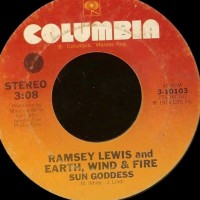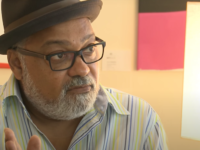Boasting focused, soul-lifting horns, sunburst harmonies and a thrilling propensity for shaken-up textures and rhythms, Earth Wind and Fire could do almost no wrong for a period of time in the early- to mid-1970s. Maurice White’s band notched eight Top 10 pop albums and eight No. 1 R&B singles to go with eight Grammy Awards. EWF was so profoundly talented, in fact, that it almost — almost — saved the Bee Gees’ staggeringly wrong-headed all-star disco reinterpretation of the Beatles’ Sgt. Pepper’s.
That fiery creative intensity faded as a new decade loomed, and then White — who passed away on Feb. 4, 2016 — fell ill. The only risk that Earth Wind and Fire was taking by then, as one critic said in a withering review, was running head-on into someone coming the other way down the middle of the road. Still, you can’t take away what came before. Their memorable brand of brass-blasting R&B positivity helped propel Earth Wind and Fire into the Rock and Roll Hall of Fame in 2000.
Here are five favorites — some familiar, some not — to remind you of just why:
“CAN’T HIDE LOVE” (GRATITUDE, 1975): Skip Scarborough penned one this best of a long string of hits he’s written over 25 years with “Can’t Hide Love,” but Maurice White’s Earth Wind and Fire brought it to its fullest potential.
This is a middle-slow groover done up to perfection: an opening four-note horn punch sequence between the beats, Verdine White’s groovalicious bass lines, and Larry Dunn’s mushy Rhodes and string-like synth washes create a jazz-meets-James Brown formula that the band used to rule soul music in the 1970s. And then there’s Maurice White coaxing a reluctant love prospect by selling it in a half menacing, half pleading voice that few other soul singers can pull off that convincingly.
Yet, it’s the coda that puts the song over the top: the horn blasts from the into return and a wordless vocal harmony led by Maurice White and Philip Bailey in a new, descending note pattern that makes “Can’t Hide Love” R&B’s answer to the Beatles’ “Hey Jude.” – S. Victor Aaron
POWER (LAST DAYS AND TIMES, 1973): A wow-man amalgam that can best be described as jazzed-up acid-funk, “Power” lives up to its name with a thunderous statement of purpose. Was there a better working R&B band back then? This instrumental certainly makes the case for Earth Wind and Fire, a group that had a frisky inventiveness to match its musical prowess.
Keyboardist Larry Dunn begins the track with a series of circular, flirtatious excursions, before guitarist Roland Bautista begins stomping on his wah-wah pedal. Together, they set about constructing a precipitous, anticipatory groove. By the time reed man Ronnie Laws bursts out, the rhythm section of bassist Verdine White (Maurice White’s brother) and a cast-of-thousands percussion group has started making a dance floor-rattling din. Then, as Laws climbs to the top of a layered, shiver-inducing vista, EWF goes dead quiet — only to see Bautista return for a deliciously funky duel with White. Switching to flute now, Laws goes on to take a heavenly sideroad but Dunn is right there, channelling Billy Preston on a sizzling turn at the clavinet.
It’s like four or five tunes, sometimes all at once. And no words. Just a swirling, head-turning good time. – Jimmy Nelson
THAT’S THE WAY OF THE WORLD (THAT’S THE WAY OF THE WORLD, 1975): I pride myself on being pretty open-minded when it comes to music. The ears are always ready for new experiences. It took me a number of years to get to this point however, with a lot of stereotypes, misconceptions, and dying sparks of epiphanies left by the roadside.
You know how it goes — you’re certain that you don’t like, say, country music … and then you hear Lyle Lovett singing “I’m So Lonesome I Could Cry” and you realize that your scoffing at the supposed genius of Hank Williams was not only misguided but just plain ignorant.
The discovery of the error of my ways concerning Earth, Wind and Fire came from an odd source: Pat Metheny. The details surfaced on an Internet discussion forum, with a fan mentioning that, just before the Metheny group starts a show, “That’s the Way of the World” is played over the PA system. This was a tradition that I’d never noticed, probably because I was wrapped up in my typical pre-concert excitement.
So, before I went to another Pat Metheny Group show I went out and bought That’s The Way Of The World, figuring that Metheny had to know what he was talking about. Sure enough, the band that I had pretty much ignored (because funk & soul did not resonate with my mid-1970s, hormone-addled brain) exuded many of the music elements that Metheny centers on, in particular soaring & uplifting melody. Thanks, Pat! – Mark Saleski
“I’LL WRITE A SONG FOR YOU” (ALL ‘N ALL, 1977): Falsetto singing in soul seems almost a lost art these days but some of the best songs from that genre came from those sung high, “like “People Make The World Go Round” and other hits by the Sylistics. Next to perhaps Stylistics front man Russell Thompkins, Jr., there may not have been a better falsetto crooner than Maurice White’s singing partner in Earth, Wind and Fire, Philip Bailey. Bailey’s signature song has always been the sultry, sweet soul ballad “Reasons,” but I think his performance on “I’ll Write a Song For You,” another gentle tone poem, is equally as good.
As with “People,” the use of strings and horns (not the funky horns, mind you, but the orchestral ones), gives the tune a majestic presence that takes it beyond the realm of soul; an acoustic guitar and a harp softens it up further. But it’s not too syrupy, because of a thoughtful arrangement that adds these touches (and Earth Wind and Fire’s world-class background harmonies) in measured doses, putting Bailey’s angelic voice right at the center of focus. He could have easily done vocal somersaults here and won plaudits for it, but instead he shows off his reserve and control. At the song’s climax around the three minute mark, Philip Bailey effortlessly carries the word “of” through every permutation of a chord like the carefree flight path of a sparrow, and sometimes it makes the hair on the back of my neck stand up.
It’s the folkish charm of a song like “I’ll Write A Song For You” with Bailey’s golden falsetto that offered proof of why Earth, Wind and Fire was much more than just another R&B band. Their whole approach to music is a lost art, too. – S. Victor Aaron
“C’MON CHILDREN” (EARTH WIND AND FIRE, 1971): In a lineup that was much different from the band’s looming period as hitmakers, Maurice White’s initial edition of Earth Wind and Fire is surprisingly tough, unleashing a greasy, almost dangerously unbridled funk that recalls the Meters.
The late White, a former sessions ace for Chess Records and member of the Ramsey Lewis Trio, mostly played drums back then — singing, before Philip Bailey’s arrival, in a guttural, shared vocal style with his bandmates. Also notable on this and other tracks from Earth Wind and Fire’s underrated debut was how it bravely dealt with a series of topical issues, aligning the group with social commentators like Marvin Gaye and Sly and the Family Stone from the same period.
In the music, you hear the first inklings of what will make this band such a ass-shaking joy. There’s something else in the lyrics: Though your local moldy oldies station is more apt to spin EWF dance-floor stuffers like “Boogie Wonderland” and “Sing a Song,” Maurice White and Co. had more to say — a lot more. – Jimmy Nelson



